Effects of Long-Term Organic–Inorganic Nitrogen Application on Maize Yield and Nitrogen-Containing Gas Emission
Abstract
1. Introduction
2. Materials and Methods
2.1. Overview of the Experimental Area and Experimental Design
2.2. Measurement Items and Methods
2.2.1. Soil Physicochemical Properties and Yield Measurement
2.2.2. Measurement of Soil Ammonia Volatilization
2.2.3. Measurement of N2O Emissions
2.3. DNDC Model
2.4. Establishment of the DNDC Model Database
2.5. Effects of Long-Term Combined Application of Organic–Inorganic Nitrogen on Crop Yield and Nitrogen-Containing Gas Emissions
2.6. Statistical Analysis of Data
3. Results
3.1. Model Evaluation
3.1.1. Yield
3.1.2. Soil Nitrate–Nitrogen Content
3.1.3. Soil Ammonia Volatilization
3.1.4. Nitrous Oxide Emissions
3.2. Maize Yield and Nitrogen-Containing Gas Emissions under Long-Term Combined Application of Organic–Inorganic Nitrogen
3.2.1. Maize Yield
3.2.2. Emissions of Nitrogen-Containing Gases
4. Discussion
4.1. Model Performance
4.2. Maize Yield under Long-Term Combined Application of Organic–Inorganic Nitrogen
4.3. Emissions of Nitrogen-Containing Gas under Long-Term Combined Application of Organic–Inorganic Nitrogen
5. Conclusions
Supplementary Materials
Author Contributions
Funding
Data Availability Statement
Conflicts of Interest
References
- Li, G.; Zhao, B.; Dong, S.; Zhang, J.; Liu, P.; Vyn, T.J. Interactive effects of water and controlled release urea on nitrogen metabolism, accumulation, translocation, and yield in summer maize. Sci. Nat. 2017, 72, 2–12. [Google Scholar] [CrossRef] [PubMed]
- Zhu, S.; Vivanco, J.M.; Manter, D.K. Nitrogen fertilizer rate affects root exudation, the rhizosphere microbiome and nitrogen-use-efficiency of maize. Appl. Soil Ecoll. 2016, 7, 324–333. [Google Scholar] [CrossRef]
- Ahmed, M.; Rauf, M.; Mukhtar, Z.; Saeed, N.A. Excessive use of nitrogenous fertilizers: An unawareness causing serious threats to environment and human health. Environ. Sci. Pollut. R. 2017, 24, 26983–26987. [Google Scholar] [CrossRef]
- Huang, Y.; Tang, Y. An estimate of greenhouse gas (N2O and CO2) mitigation potential under various scenarios of nitrogen use efficiency in Chinese croplands. Glob. Chang. Biol. 2010, 16, 2958–2970. [Google Scholar] [CrossRef]
- Liu, H.M.; Pang, F.J.; Lan, X.; Yang, D.L. Effects of nitrogen fertilizer rate and combined application of organic manure and chemical fertilizer on soil ammonia volatilization in winter-wheat field. J. Anhui Agric. Sci. 2012, 40, 7119–7122. [Google Scholar]
- Ting, L.; He, X.Q.; Wang, Q.; Deng, O.P.; Zhou, W.; Luo, L.; Chen, G.D.; Zeng, J.; Yuan, S.; Zeng, M.; et al. Synergistic effects of biological nitrification inhibitor, urease inhibitor, and biochar on NH3 volatilization, N leaching, and nitrogen use efficiency in a calcareous soil–wheat system. Appl. Soil Ecol. 2022, 174, 104412. [Google Scholar]
- Seinfeld, J.H.; Pandis, S.N. Atmospheric Chemistry and Physics: From Air Pollution to Climate Change; John Wiley & Sons, Inc.: New York, NY, USA, 2006. [Google Scholar]
- Feng, Y.Y.; Feng, Y.F.; Liu, Q.; Chen, S.; Hou, P.F.; Gerrard, P.; Jiang, Z.T.; Derek, F.; Xue, L.H.; Su, S.L.; et al. How does biochar aging affect NH3 volatilization and GHGs emissions from agricultural soils? Environ. Pollut. 2021, 294, 118598. [Google Scholar] [CrossRef]
- Rosa, M.C.B.; Óscar, V.G.; Emilio, J.; Rafaela, O.F.; Manuel, M.G.; Miguel, A.; Repullo-Ruibérriz, D.T. Soil management, irrigation and fertilisation strategies for N2O emissions mitigation in mediterranean agricultural systems. Agronomy 2022, 12, 104412. [Google Scholar]
- Davidson, E.A. The contribution of manure and fertilizer nitrogen to atmospheric nitrous oxide since 1860. Nat. Geosci. 2009, 2, 659–662. [Google Scholar] [CrossRef]
- Erisman, J.W.; Sutton, M.A.; Galloway, J.; Klimont, Z.; Winiwarter, W. How a century of ammonia synthesis changed the world. Nat. Geosci. 2008, 1, 636–639. [Google Scholar] [CrossRef]
- Smith, L.E.D.; Siciliano, G.A. Comprehensive review of constraints to improved management of fertilizers in China and mitigation of diffuse water pollution from agriculture. Agr. Ecosyst. Environ. 2015, 1, 15–25. [Google Scholar] [CrossRef]
- Li, S.; Li, Y.B.; Li, X.S.; Zhao, A.Q.; Wang, S.J. Effect of straw management on carbon sequestration and grain production in a maize-wheat cropping system in Anthrosol of the Guanzhong Plain. Soil Till. Res. 2016, 157, 43–51. [Google Scholar] [CrossRef]
- Baruah, A.; Baruah, K.K.; Bhattacharyya, P. Comparative Effectiveness of Organic Substitution in Fertilizer Schedule: Impacts on Nitrous Oxide Emission, Photosynthesis, and Crop Productivity in a Tropical Summer Rice Paddy. Water Air Soil Poll. 2016, 227, 410–416. [Google Scholar] [CrossRef]
- Guo, L.Y.; Wu, G.L.; Li, Y.; Li, C.H.; Liu, W.J.; Meng, J.; Liu, H.; Fan, X.Y.; Jiang, G.M. Effects of cattle manure compost combined with chemical fertilizer on topsoil organic matter, bulk density and earthworm activity in a wheat-maize rotation system in Eastern China. Soil Till. Res. 2016, 156, 140–147. [Google Scholar] [CrossRef]
- Manna, M.C.; Swarup, A.; Wanjari, R.H.; Ravankar, H.N.; Mishra, B.; Saha, M.N.; Singh, Y.V.; Saha, D.K.; Sarap, P.A. Long-term effect of fertilizer and manure application on soil organic carbon storage, soil quality and yield sustainability under sub-humid and semi-arid tropical India. Field Crop. Res. 2005, 93, 264–280. [Google Scholar] [CrossRef]
- Yadav, R.L.; Dwivedi, B.S.; Prasad, K.; Tomar, O.K.; Shurpali, N.J.; Pandey, P.S. Yield trends, and changes in soil organic-C and available NPK in a long-term rice-wheat system under integrated use of manures and fertilisers. Field Crop. Res. 2000, 68, 219–246. [Google Scholar] [CrossRef]
- Duncan, E.W.; Dell, C.J.; Kleinman, P.J.A.; Beegle, D.B. Nitrous oxide and ammonia emissions from injected and broadcast-applied dairy slurry. J. Environ. Qual. 2017, 46, 36–44. [Google Scholar] [CrossRef]
- Matsushima, M.; Lim, S.; Kwak, J.; Park, H.; Lee, S.; Lee, D.; Choi, W. Interactive effects of synthetic nitrogen fertilizer and composted manure on ammonia volatilization from soils. Plant Soil. 2009, 325, 187–196. [Google Scholar] [CrossRef]
- Li, L.; You, M.; Shi, H.; Ding, X.; Qiao, Y.; Han, X. Soil CO2 emissions from a cultivated Mollisol: Effects of organic amendments, soil temperature, and moisture. Eur. J. Soil Biol. 2013, 55, 83–90. [Google Scholar] [CrossRef]
- Yang, Q.L.; Liu, P.; Dong, S.T.; Zhang, J.W.; Zhao, B. Combined application of organic and inorganic fertilizers mitigates ammonia and nitrous oxide emissions in a maize field. Nutr. Cycl. Agroecosyst. 2020, 117, 13–27. [Google Scholar] [CrossRef]
- Cui, F.; Yan, G.X.; Zhou, Z.X.; Zheng, X.H.; Deng, J. Annual emissions of nitrous oxide and nitric oxide from a wheat–maize cropping system on a silt loam calcareous soil in the North China Plain. Soil Biol. Biochem. 2012, 48, 10–19. [Google Scholar] [CrossRef]
- Jain, N.; Arora, P.; Tomer, R.; Mishra, S.V.; Bhatia, A.; Pathak, H.; Chakraborty, D.; Kumar, V.; Dubey, D.S.; Harit, R.C.; et al. Greenhouse gases emission from soils under major crops in Northwest India. Sci. Total Environ. 2016, 542, 551–561. [Google Scholar] [CrossRef]
- Van Groenigen, J.W.; Velthof, G.L.; Oenema, O.; Van Groenigen, K.J.; Van Kessel, C. Towards an agronomic assessment of N2O emissions: A case study for arable crops. Eur. J. Soil Sci. 2010, 61, 903–913. [Google Scholar] [CrossRef]
- Liu, X.M.; Gu, W.R.; Li, C.F.; Li, J.; Wei, S. Effects of nitrogen fertilizer and chemical regulation on spring maize lodging characteristics, grain filling and yield formation under high planting density in Heilongjiang Province, China-ScienceDirect. J. Integr. Agric. 2021, 20, 511–526. [Google Scholar] [CrossRef]
- Qiu, J.J.; Li, H.; Wang, L.G.; Tang, H.J.; Li, C.S.; Van Ranst, E. GIS-model based estimation of nitrogen leaching from croplands of China. Nutr. Cycl. Agroecosyst. 2011, 90, 243–252. [Google Scholar] [CrossRef]
- Cui, M.; Sun, X.; Hu, C.; Di, H.; Tan, Q.; Zhao, C. Effective mitigation of nitrate leaching and nitrous oxide emissions in intensive vegetable production systems using a nitrification inhibitor, dicyandiamide. J. Soils Sediments 2011, 11, 722–730. [Google Scholar] [CrossRef]
- Li, H.; Wang, L.; Qiu, J.; Li, C.; Gao, M.; Gao, C. Calibration of DNDC model for nitrate leaching from an intensively cultivated region of Northern China. Geoderma 2014, 223–225, 108–118. [Google Scholar] [CrossRef]
- Brilli, L.; Bechini, L.; Bindi, M.; Carozzi, M.; Cavalli, D.; Conant, R.; Dorich, C.D.; Doro, L.; Ehrhardt, F.; Farina, R.; et al. Review and analysis of strengths and weaknesses of agro-ecosystem models for simulating C and N fluxes. Sci. Total Environ. 2017, 598, 445–470. [Google Scholar] [CrossRef]
- Butterbach-Bahl, K.; Baggs, E.M.; Dannenmann, M.; Kiese, R.; Zechmeister-Boltenstern, S. Nitrous oxide emissions from soils: How well do we understand the processes and their controls? Philos. Trans. R. Soc. B Biol. Sci. 2013, 368, 20130122. [Google Scholar] [CrossRef]
- Giltrap, D.L.; Li, C.; Saggar, S. DNDC: A process-based model of greenhouse gas fluxes from agricultural soils. Agric. Ecosyst. Environ. 2010, 136, 292–300. [Google Scholar] [CrossRef]
- Li, Z.; Shi, H.B.; Li, X.Y.; Yan, J.W. Ammonia volatilization in soil and grain yield of the spring maize under different water-nitrogen management regimes. J. Agro-Environ. Sci. 2017, 36, 799–807. [Google Scholar]
- Diacono, M.; Montemurro, F. Long-term effects of organic amendments on soil fertility (A review). Agron. Sustain. Dev. 2010, 30, 401–422. [Google Scholar] [CrossRef]
- Wang, Z.H.; Liu, X.J.; Ju, X.T.; Zhang, F.S. Field in situ determination of ammonia volatilization from soil: Venting method. Plant Nutr. Fertil. Sci. 2002, 8, 205–209. [Google Scholar]
- Hutchinson, G.L.; Livingston, G.P. Use of Chamber Systems to Measure Trace Gas Fluxes; ASA Special Publication: Madison, WI, USA, 1993; Volume 41, pp. 63–78. [Google Scholar]
- Lv, F.L.; Song, J.S.; Giltrp, D.; Feng, Y.T.; Yang, X.Y.; Zhang, S.L. Crop yield and N2O emission affected by long-term organic manure substitution fertilizer under winter wheat-summer maize cropping system. Sci. Total Environ. 2020, 732, 9684–9697. [Google Scholar] [CrossRef]
- Zhang, W.; Liu, C.Y.; Zheng, X.H.; Zhou, Z.X.; Cui, F. Comparison of the DNDC, Landscape DNDC and IAP-N-GAS models for simulating nitrous oxide and nitric oxide emissions from the winter wheat-summer maize rotation system. Agr. Syst. 2015, 140, 1–10. [Google Scholar] [CrossRef]
- Chirinda, N.; Kracher, D.; Mette, L.; Porter John, R.; Olesen, J.E.; Petersen, B.M.; Doltra, J.K.; Klaus, B. Simulating soil N2O emissions and heterotrophic CO2 respiration in arable systems using FASSET and Mo Bi LE-DNDC. Plant. Soil. 2011, 343, 139–160. [Google Scholar] [CrossRef]
- Li, C.F.; Zhou, D.N.; Kou, Z.K.; Zhang, Z.S.; Wang, J.P.; Cai, M.L.; Cao, C.G. Effects of tillage and nitrogen fertilizers on CH4 and CO2 emissions and soil organic carbon in paddy fields of central China. PLoS ONE 2012, 7, e34642. [Google Scholar]
- Yang, J.M.; Yang, J.Y.; Liu, S.; Hoogenboom, G. An evaluation of the statistical methods for testing the performance of crop models with observed data. Agr. Syst. 2014, 127, 81–89. [Google Scholar] [CrossRef]
- Shaukat, M.; Muhammad, S.; Maas, E.; Khaliq, T.; Ahmad, A. Predicting methane emissions from paddy rice soils under biochar and nitrogen addition using dndc model. Ecol. Model. 2022, 466, 10896. [Google Scholar] [CrossRef]
- Babu, Y.J.; Li, C.; Frolking, S.; Adhya, T.K. Field validation of DNDC model for methane and nitrous oxide emission from rice-based production systems of India. Nutr. Cycl. Agroecosyst. 2006, 74, 157–174. [Google Scholar] [CrossRef]
- Zhou, H.; Shi, H.B.; Xu, Z.; Guo, J.W.; Fu, X.J.; Li, Z.Z. Effects of combined application of organic and inorganic fertilizers on nitrogen supply and crop water and nitrogen utilization in salinized soils. Trans. Chin. Soc. Agric. Mach. 2020, 51, 299–307. [Google Scholar]
- Xu, F.; Liu, Y.; Du, W.; Li, C.L.; Xu, M.L.; Xie, t.c.; Ying, Y.; Guo, H.G. Response of soil bacterial communities, antibiotic residuals, and crop yields to organic fertilizer substitution in North China under wheat-maize rotation. Sci. Total Environ. 2021, 785, 147248. [Google Scholar] [CrossRef]
- Cheng, H.G.; Zhang, D.Q.; Huang, B.; Song, Z.X.; Ren, L.R.; Hao, B.Q.; Liu, J.; Zhu, J.H.; Fang, W.S.; Yan, D.D.; et al. Organic fertilizer improves soil fertility and restores the bacterial community after 1,3-dichloropropene fumigation. Sci. Total Environ. 2020, 738, 140345. [Google Scholar] [CrossRef] [PubMed]
- Dimkpa, C.O.; Fugice, J.; Singh, U.; Lewis, T.D. Development of fertilizers for enhanced nitrogen use efficiency—Trends and perspectives. Sci. Total Environ. 2020, 731, 139113. [Google Scholar] [CrossRef] [PubMed]
- Shan, J.; Yan, X.Y. Effects of crop residue returning on nitrous oxide emissions in agricultural soils. Atmos. Environ. 2013, 71, 170–175. [Google Scholar] [CrossRef]
- Yao, Z.S.; Zheng, X.H.; Xie, B.H.; Mei, B.L.; Wang, R.; Butterbach-Bahl, K.; Zhu, J.G.; Yin, R. Tillage and crop residue management significantly affects N-trace gas emissions during the non-rice season of a subtropical rice-wheat rotation. Soil Biol. Biochem. 2009, 41, 2131–2140. [Google Scholar] [CrossRef]
- Zhang, H.M.; Yang, X.Y.; He, X.H.; Xu, M.G. Effect of long-term potassium fertilization on crop yield and potassium efficiency and balance under wheat-maize rotation in China. Pedosphere 2011, 21, 154–163. [Google Scholar] [CrossRef]
- Ding, W.X.; Lei, M.; Cai, Z.C.; Han, F.X. Effects of long-term amendment of organic manure and nitrogen fertilizer on nitrous oxide emission in a sandy loam soil. J. Environ. Sci. 2007, 19, 185–193. [Google Scholar] [CrossRef]
- Zhang, Y.L.; Zhang, J.; Shen, Q.R.; Wang, J.C. Effect of combined application of bioorganic manure and inorganic nitrogen fertilizer on soil nitrogen supplying characteristics. J. Appl. Ecol. 2002, 13, 1575–1578. [Google Scholar]
- Muller, C.; Stevens, R.J.; Laughlin, R.J. Evidence of carbon stimulated N transformations in grassland soil after slurry application. Soil Biol. Biochem. 2003, 35, 285–293. [Google Scholar] [CrossRef]
- Azam, F.; Muller, C.; Weiske, A.; Benckiser, G.; Ottow, J.C.G. Nitrification and denitrification as sources of atmospheric nitrous oxide-role of oxidizable carbon and applied nitrogen. Biol. Fert. Soils 2002, 35, 54–61. [Google Scholar]
- Tatti, E.; Goyer, C.; Zebarth, B.J.; Viti, C.; Burton, D.L. Short-term effects of mineral and organic fertilizer on denitrifiers, nitrous oxide emissions and denitrification in long-term amended vineyard soils. Soil Sci. Soc. Am. J. 2013, 77, 113–122. [Google Scholar] [CrossRef]
- Kira, O.; Shaviv, A.; Dubowski, Y. Direct tracing of NH3 and N2O emissions associated with urea fertilization approaches, using static incubation cells—ScienceDirect. Sci. Total Environ. 2019, 661, 75–85. [Google Scholar] [CrossRef] [PubMed]
- Zheng, F.X.; Dong, S.T.; Liu, P. Effects of combined application of manure and chemical fertilizers on ammonia volatilization loss and yield of winter wheat. J. Plant Nutr. Fert. 2017, 23, 567–577. [Google Scholar]
- Dong, W.X.; Hu, C.S.; Zhang, Y.M.; Cui, J.F. Ammonia Volatilization from Urea Incorporation with Wheat and Maize Straw on a Loamy Soil in China: The Proceedings of the International Plant Nutrition Colloquium XVI; University of California: Davis, CA, USA, 2009. [Google Scholar]
- Bhattarai, N.; Wang, S.; Xu, Q.; Dong, Z.X.; Chang, X.; Jiang, Y.Q.; Zheng, H.T. Sources of gaseous NH3 in urban Beijing from parallel sampling of NH3 and NH4+, their nitrogen isotope measurement and modeling. Sci. Total Environ. 2020, 747, 141361. [Google Scholar] [CrossRef] [PubMed]
- Guo, Y.J.; Ji, Y.Z.; Zhang, J.; Liu, Q.; Han, J.; Zhang, L.J. Effects of water and nitrogen management on N2O emissions and NH3 volatilization from a vineyard in North China. Agric. Water Manag. 2022, 266, 107601. [Google Scholar] [CrossRef]
- Chen, G.; Liu, H.; Zhang, J.; Liu, P.; Dong, S. Factors affecting summer maize yield under climate change in Shandong Province in the Huanghuaihai Region of China. Int. J. Biometeorol. 2012, 56, 621–629. [Google Scholar] [CrossRef]
- Dangi, K.; Singh, S.; Malviya, D.; Gautam, A.; Kanapuriya, N.; Kumar, B. Effect of Rice Varieties on Growth, Yield and Economics at Varying Levels of Nitrogen under Direct Seeded Upland Condition Rewa Region. Int. J. Curr. Microbiol. Appl. Sci. 2017, 6, 2313–2318. [Google Scholar] [CrossRef]
- Watson, J.; Zheng, B.Y.; Chapman, S.; Chenu, K. Projected impact of future climate on water-stress patterns across the Australian wheatbelt. J. Exp. Bot. 2017, 68, 5907–5921. [Google Scholar] [CrossRef]
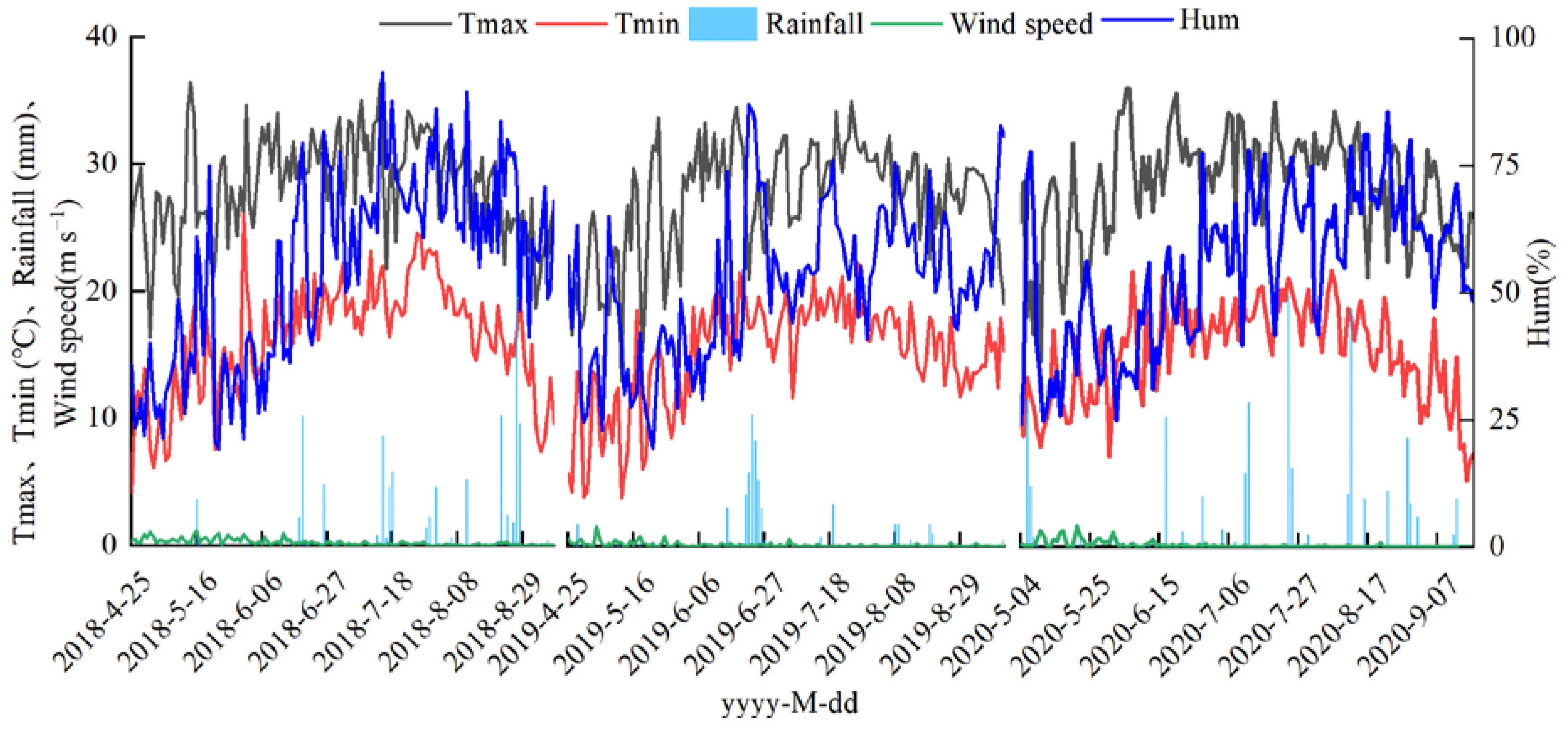
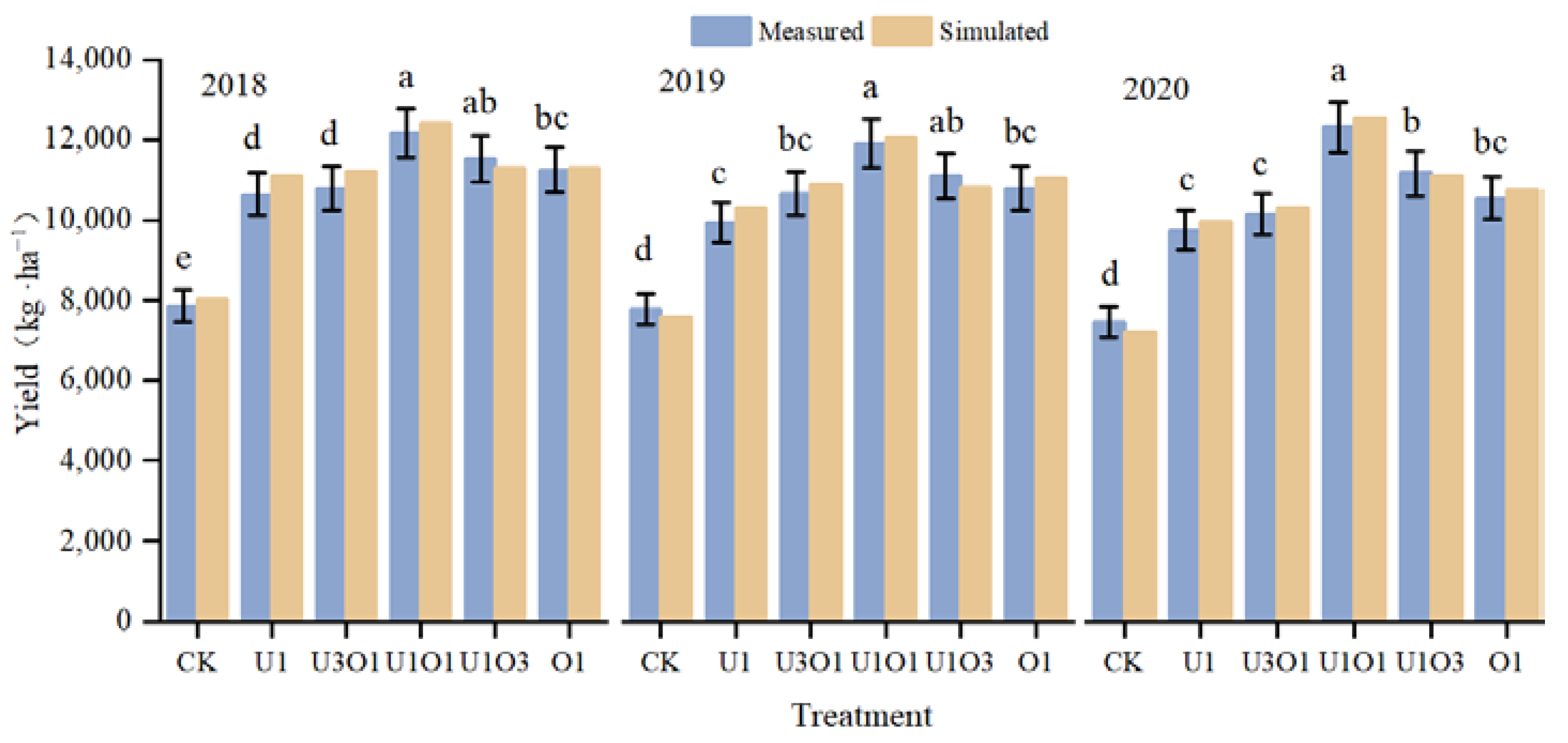
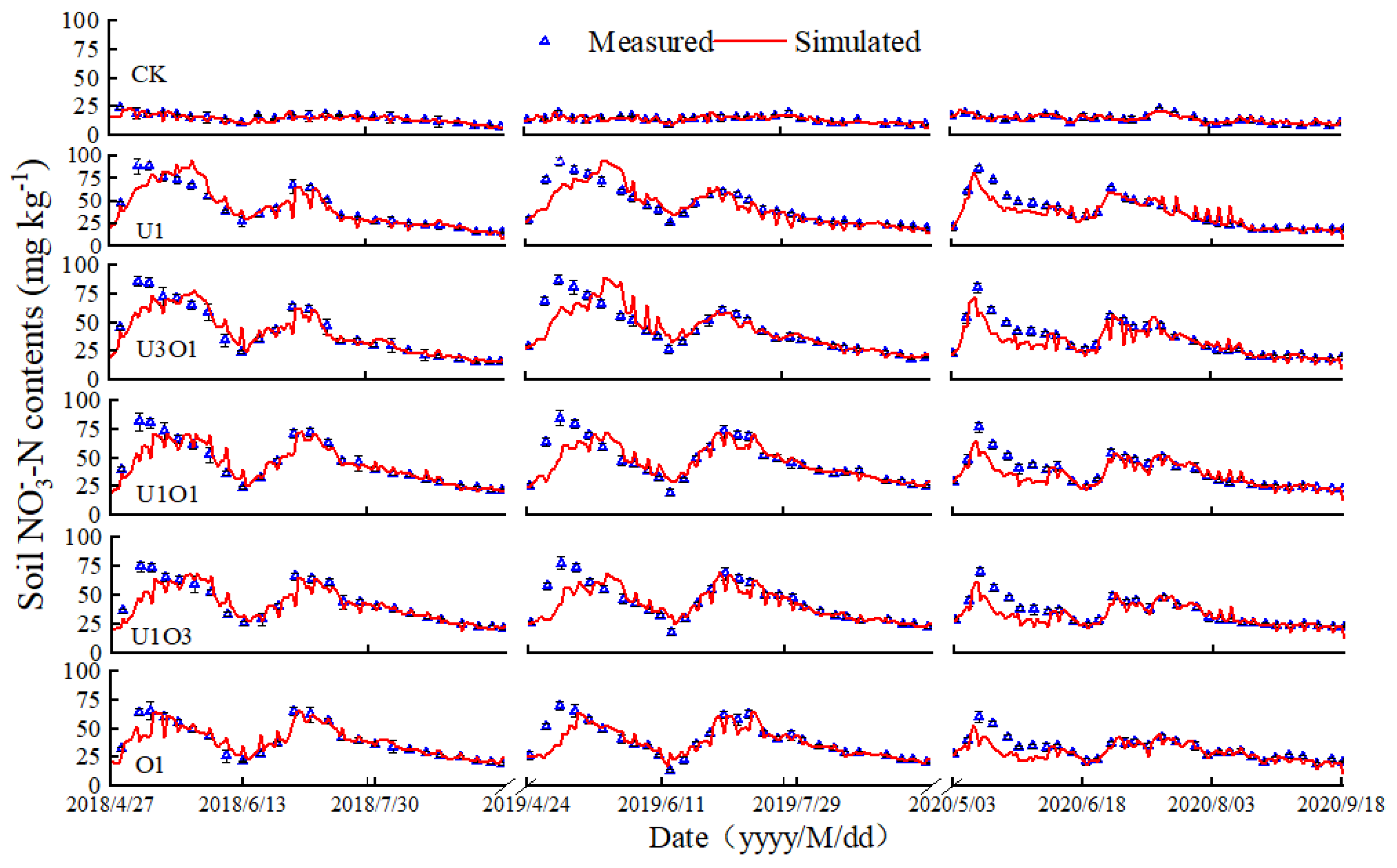

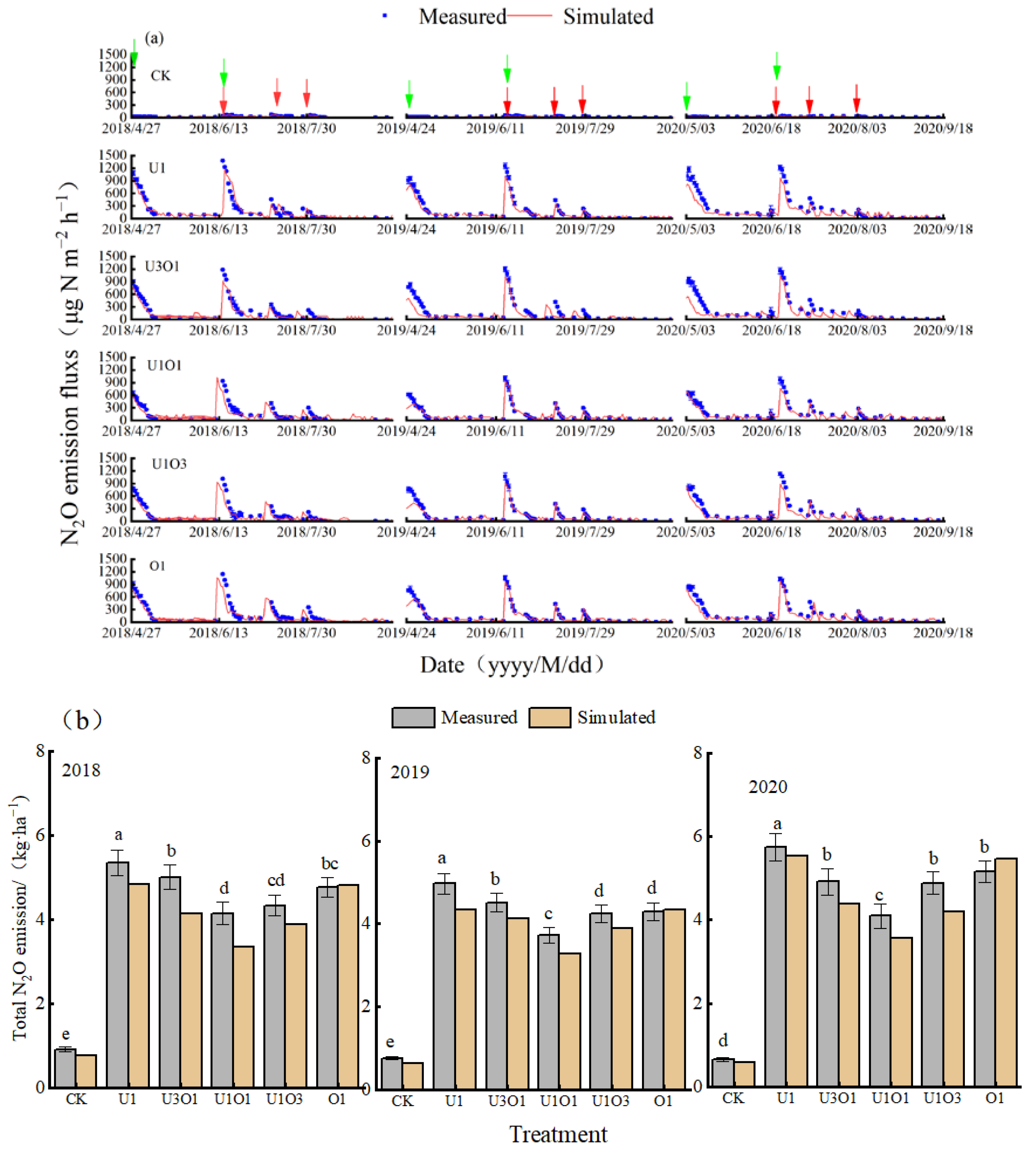
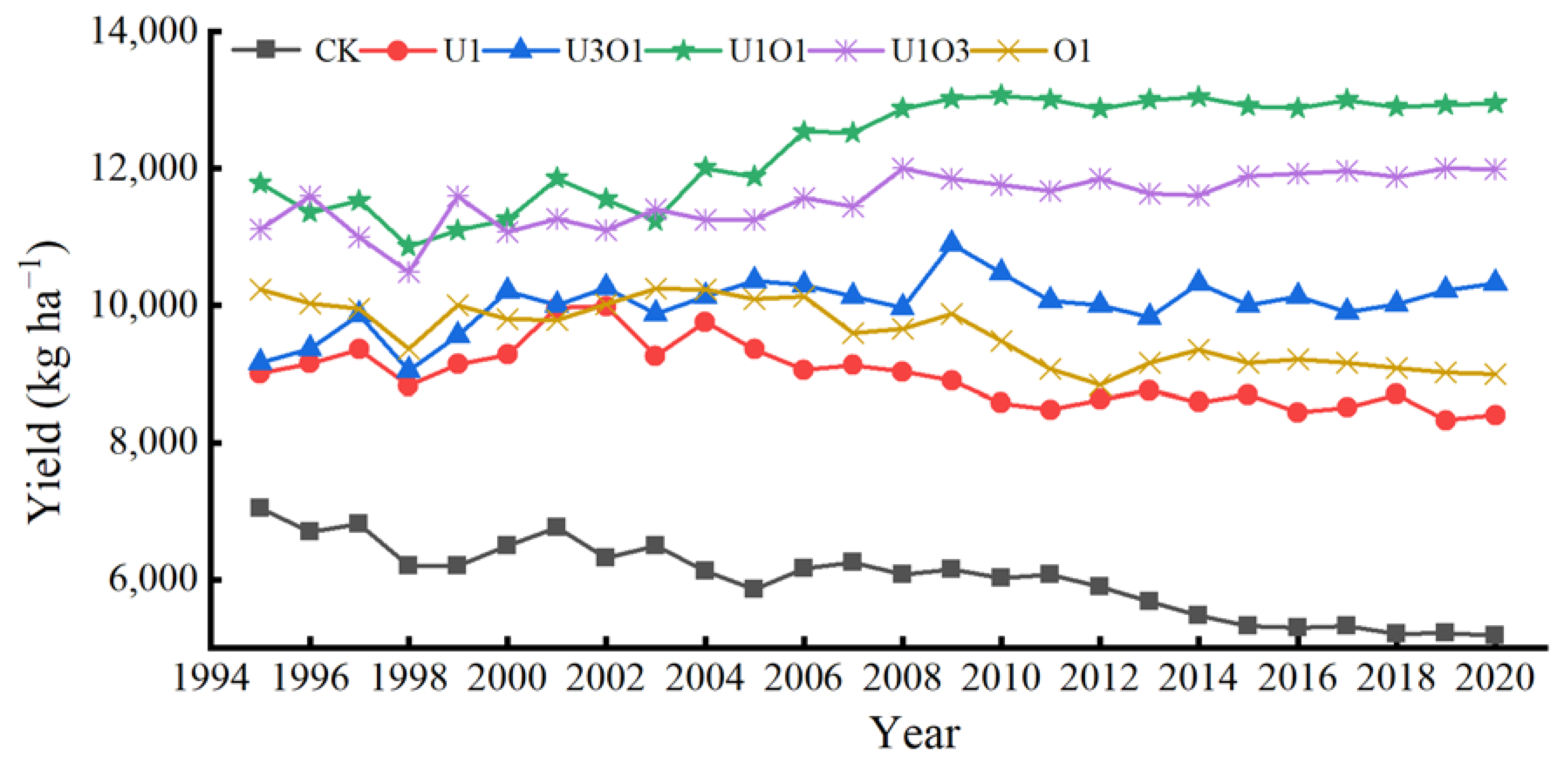

| Soil Layer | Organic Matter (g kg−1) | Total N (g kg−1) | Alkaline Hydrolysis N (mg kg−1) | Available P (mg kg−1) | Available K (mg kg−1) | pH |
|---|---|---|---|---|---|---|
| 0–20 cm | 14.04 | 1.43 | 54.68 | 37.78 | 199.67 | 8.2 |
| 20–40 cm | 5.25 | 0.36 | 10.25 | 6.52 | 102.25 | 8.0 |
| 40–60 cm | 1.52 | 0.15 | 8.15 | 8.15 | 30.36 | 7.8 |
| 60–100 cm | 0.38 | 0.10 | 2.53 | 1.32 | 10.32 | 7.6 |
| Parameter | Value |
|---|---|
| Target yield (kg·C−1) | 4800 |
| Grains/stems and leaves/roots | 0.4/0.42/0.15 |
| Total nitrogen demand (kg ha−1) | 220 |
| Accumulated temperature (°C) | 2400 |
| Water requirement (g g−1) | 350 |
| Bulk density (g cm3) | 1.37 |
| Clay content (%) | 9.86 |
| Nitrogen fixation coefficient | 1 |
| Treatment | Measured Value (kg ha−1) | MBE (kg ha−1) | RMSE (kg ha−1) | nRMSE (%) | R2 |
|---|---|---|---|---|---|
| Calibration | |||||
| U1 | 10,120.82 ± 506.04 | 192.1 | 185.47 | 2.63 | 0.99 |
| Validation | |||||
| CK | 7714.69 ± 385.73 | 133.25 | 289.56 | 4.05 | 0.97 |
| U3O1 | 10,544.61 ± 527.23 | 253.63 | 315.29 | 3.84 | 0.98 |
| U1O1 | 12,133.81 ± 606.69 | 352.1 | 300.25 | 3.12 | 0.98 |
| U1O3 | 11,275.39 ± 563.77 | −97.17 | 332.65 | 2.98 | 0.97 |
| O1 | 10,872.25 ± 543.61 | −59.63 | 367.53 | 3.74 | 0.98 |
| Treatment | Measured Value (kg ha−1) | MBE (mg kg−1) | RMSE (mg kg−1) | nRMSE (%) | R2 |
|---|---|---|---|---|---|
| CK | 14.48 ± 1.17 | −4.55 | 12.99 | 22.58 | 0.69 |
| U1 | 41.29 ± 2.54 | −3.29 | 12.19 | 18.82 | 0.72 |
| U3O1 | 40.25 ± 2.53 | −3.69 | 12.59 | 18.89 | 0.70 |
| U1O1 | 43.54 ± 2.68 | −2.81 | 13.36 | 19.36 | 0.71 |
| U1O3 | 40.60 ± 2.41 | 0.26 | 13.80 | 21.05 | 0.71 |
| O1 | 37.00 ± 2.30 | 1.91 | 12.58 | 20.57 | 0.69 |
| Treatment | Measured Value | MBE | RMSE | nRMSE (%) | R2 | |
|---|---|---|---|---|---|---|
| Daily NH3 Flux | CK | 0.07 ± 0.01 | 0.15 | 0.21 | 16.57 | 0.62 |
| U1 | 0.20 ± 0.02 | −0.52 | 0.15 | 17.26 | 0.83 | |
| U3O1 | 0.87 ± 0.04 | −0.33 | 0.22 | 18.01 | 0.75 | |
| U1O1 | 0.78 ± 0.05 | −0.41 | 0.31 | 18.25 | 0.79 | |
| U1O3 | 0.65 ± 0.05 | −0.28 | 0.65 | 20.43 | 0.71 | |
| O1 | 0.73 ± 0.07 | −0.10 | 0.25 | 20.21 | 0.66 | |
| Annual NH3 Flux | CK | 3.45 ± 0.56 | 1.58 | 1.20 | 11.02 | 0.79 |
| U1 | 15.54 ± 0.80 | −6.42 | 2.06 | 10.69 | 0.91 | |
| U3O1 | 13.85 ± 0.78 | −4.59 | 3.56 | 13.52 | 0.83 | |
| U1O1 | 11.66 ± 0.82 | −5.16 | 4.21 | 13.79 | 0.75 | |
| U1O3 | 13.03 ± 0.70 | −3.29 | 4.02 | 17.33 | 0.77 | |
| O1 | 13.40 ± 0.76 | −4.12 | 5.15 | 15.89 | 0.74 |
| Treatment | Measured Value | MBE | RMSE | nRMSE (%) | R2 | |
|---|---|---|---|---|---|---|
| Daily N2O Flux | CK | 29.61 ± 1.54 | 50.56 | 2.40 | 23.12 | 0.65 |
| U1 | 329.19 ± 18.83 | −253.59 | 19.21 | 20.41 | 0.73 | |
| U3O1 | 285.55 ± 17.25 | −200.98 | 50.25 | 24.15 | 0.71 | |
| U1O1 | 224.35 ± 18.00 | −214.25 | 49.98 | 25.19 | 0.68 | |
| U1O3 | 256.53 ± 15.29 | −109.65 | 65.56 | 23.46 | 0.64 | |
| O1 | 274.68 ± 14.60 | −191.91 | 56.32 | 22.41 | 0.69 | |
| Annual N2O Flux | CK | 0.78 ± 0.05 | 0.28 | 0.80 | 12.53 | 0.72 |
| U1 | 5.36 ± 0.30 | −0.69 | 1.15 | 13.25 | 0.71 | |
| U3O1 | 4.81 ± 0.27 | −0.52 | 2.31 | 13.58 | 0.75 | |
| U1O1 | 3.99 ± 0.25 | −0.55 | 3.02 | 14.59 | 0.81 | |
| U1O3 | 4.48 ± 0.24 | −0.12 | 3.85 | 15.00 | 0.80 | |
| O1 | 4.74 ± 0.24 | −0.62 | 4.33 | 15.60 | 0.82 |
| Treatment | 1995–1999 | 2000–2004 | 2005–2009 | 2010–2014 | 2015–2020 | Average |
|---|---|---|---|---|---|---|
| CK | 6592.54 ± 45 d | 6440.38 ± 31 d | 6097.32 ± 24 e | 5829.91 ± 19 d | 5257.74 e | 6013.35 e |
| U1 | 9093.02 ± 26 c | 9345.82 ± 38 c | 9092.784 ± 31 d | 8605.20 ± 31 c | 8512.68 d | 8971.55 d |
| U3O1 | 9396.81 ± 45 c | 10,091.34 ± 39 b | 10,326.48 ± 16 c | 10,133.69 ± 40 b | 10,096.23 c | 10,012.27 c |
| U1O1 | 11,322.79 ± 46 a | 11,578.47 ± 25 a | 12,564.75 ± 41 a | 12,996.62 ± 72 a | 12,927.54 a | 12,303.02 a |
| U1O3 | 11,154.61 ± 67 a | 11,214.91 ± 55 a | 11,622.89 ± 39 ab | 11,703.25 ± 43 a | 11,939.81 ab | 11,542.96 ab |
| O1 | 9912.11 ± 55 b | 10,014.44 ± 39 b | 9468.832 ± 26 c | 8777.41 ± 32 c | 9101.92 cd | 9595.21 cd |
Disclaimer/Publisher’s Note: The statements, opinions and data contained in all publications are solely those of the individual author(s) and contributor(s) and not of MDPI and/or the editor(s). MDPI and/or the editor(s) disclaim responsibility for any injury to people or property resulting from any ideas, methods, instructions or products referred to in the content. |
© 2023 by the authors. Licensee MDPI, Basel, Switzerland. This article is an open access article distributed under the terms and conditions of the Creative Commons Attribution (CC BY) license (https://creativecommons.org/licenses/by/4.0/).
Share and Cite
Zhou, H.; Wang, Y.; Wang, J.; Liu, H.; Li, H.; Guo, J. Effects of Long-Term Organic–Inorganic Nitrogen Application on Maize Yield and Nitrogen-Containing Gas Emission. Agronomy 2023, 13, 848. https://doi.org/10.3390/agronomy13030848
Zhou H, Wang Y, Wang J, Liu H, Li H, Guo J. Effects of Long-Term Organic–Inorganic Nitrogen Application on Maize Yield and Nitrogen-Containing Gas Emission. Agronomy. 2023; 13(3):848. https://doi.org/10.3390/agronomy13030848
Chicago/Turabian StyleZhou, Hui, Yongqiang Wang, Jian Wang, Hu Liu, Hongfang Li, and Jiawei Guo. 2023. "Effects of Long-Term Organic–Inorganic Nitrogen Application on Maize Yield and Nitrogen-Containing Gas Emission" Agronomy 13, no. 3: 848. https://doi.org/10.3390/agronomy13030848
APA StyleZhou, H., Wang, Y., Wang, J., Liu, H., Li, H., & Guo, J. (2023). Effects of Long-Term Organic–Inorganic Nitrogen Application on Maize Yield and Nitrogen-Containing Gas Emission. Agronomy, 13(3), 848. https://doi.org/10.3390/agronomy13030848





